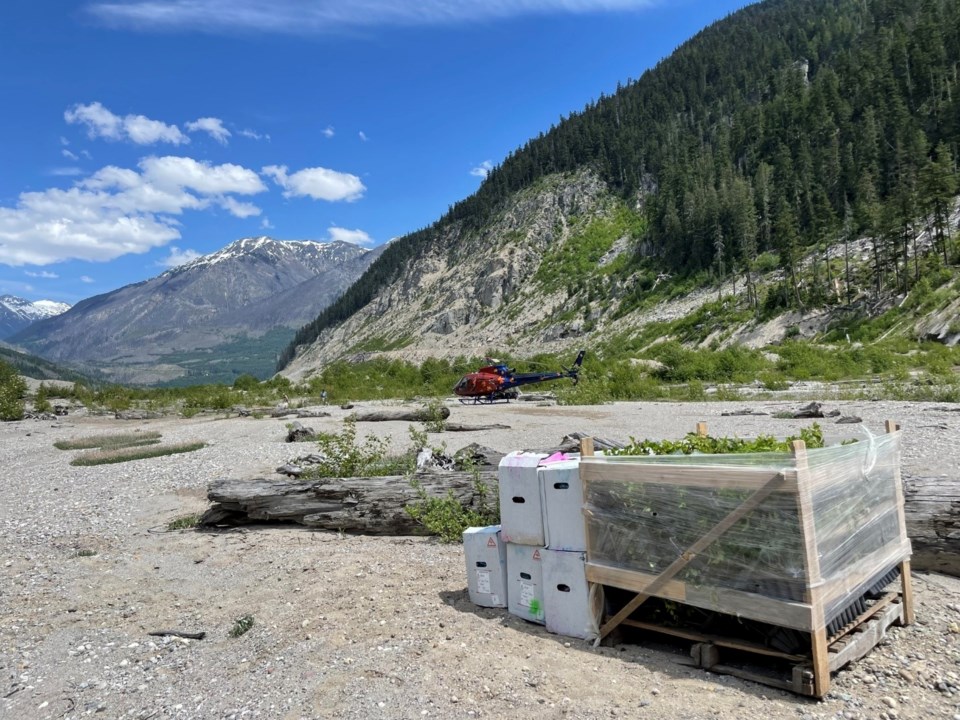Fifteen years ago, the Q̓welq̓welústen/Mount Meager landslide unleashed 50 million cubic metres of debris into the Lillooet River Valley—disrupting fish habitat and increasing flood risk down to Pemberton.
This April, as part of a years-long restoration effort, Lil’wat Forestry Ventures (LFV) oversaw the planting of more than 132,000 native trees in an effort to stabilize the debris-laden landscape and speed ecological recovery.
“After the Meager landslide, there was a lot of debris in the Lillooet River that runs through the Pemberton Valley,” explained LFV forestry technician Levi Robson. “The idea behind this replanting was to help accelerate reforestation in those areas. Having these trees here is also going to help stabilize the banks and contribute to healthier riparian habitat for creatures in that stream.”
Restoration efforts began in 2019 when the Habitat Conservation Trust Foundation provided seed funding to Lil’wat Nation. In 2022, LFV received funding from the Ministry of Forests’ Forest Investment Program to launch trial replanting efforts, which would in turn be used to inform a long-term restoration plan. The work kicked off in 2023, with 33,000 trees and shrubs planted on a 13-hectare site.
LFV was named a finalist in the Real Estate Foundation of BC’s (REFBC) 2024 Land Awards in the Land Use and Conservation Category for its restoration work at Meager.
The latest phase of the landslide restoration project wrapped after planting the seedlings between April 15 and 21. Subcontracted crews from Peek-a-Boo Services, led by Robin Bellavance, carried out the bulk of the planting this April, seeding a mix of native species including cottonwood, alder, cedar, Douglas fir and Western larch.
“Robin and his crew of tree planters have extensive experience planting sites on the coast of B.C.,” said Codie Johnston, silviculture project manager at Chartwell Resource Group Ltd., another partner on the project.
“They did a great job of getting the seedlings into the ground in a timely manner with excellent quality.”
The reforestation teams began by surveying the terrain, selecting only the areas most suitable for new growth—a challenging task given that some of the landslide zone is flood-prone or is otherwise not fit for planting.
“We asked, ‘Can we even get a shovel in the ground here, or is it just a compacted cobble layer?’” recalled Robson. “We did test a few plots to figure that out.”
The crews’ strategic decisions included where and what to plant; given the high solar exposure of the valley bottom, crews targeted northeast-facing slopes and shaded zones. They also received a planting variance from the B.C. Ministry of Forests to trial planting the Western larch species.
“We chose this species as it is more drought resistant than Douglas fir and has been identified as a species for assisted migration in previous studies,” explained Johnston.
The crews’ long-term goal is to reduce erosion and sediment accumulation downstream. Currently, dredging is required every year at the head of Lillooet Lake to maintain the river's flow and protect local infrastructure.
“This project is important to the Lil’wat Nation and community members of Pemberton, as it will reduce sediments building up at the head of Lillooet Lake and other areas along the river that are being dredged out annually to ensure the dikes continue to be effective,” Johnston said.
“Restoration planting will also increase species diversity in the river valley and provide more habitat for mammals, birds and amphibians”
For more information and ongoing updates on the project, visit the storymap website or the restoration’s Facebook page.




